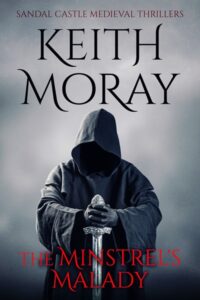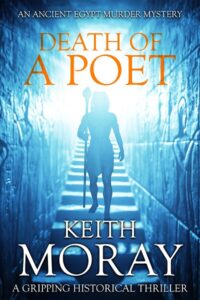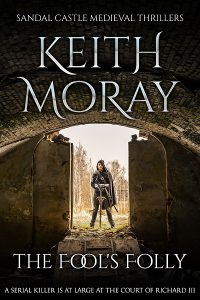Following the success of his many historical series, including the Sandal Castle Medieval Thrillers and Inspector Torquil McKinnon Mystery Series, we are delighted to announce that we have signed a new supernatural series set in Victorian London by Keith Moray.
In Keith’s words:
“The first book in the series is set in London in 1854. Jack Moon is a foundling, brought up in an orphanage and then a workhouse, where he and his best friend Danny are subject to regular beatings. Together they escape, but when Danny dies in tragic circumstances, Jack secretly buries his friend in a cemetery at night.
“Alone and living in a deserted and rat-infested warehouse, Jack starts seeing Danny’s ghost, who warns him that someone is out to kill him and worse, the girl he loves, too. This is Victorian London, with its criminal underworld, body-snatchers, phrenologists, séances, ghosts and ghouls.
“I am delighted to be writing another historical series with Sapere Books, who have permitted me to set my stories in a variety of times and places, from ancient Egypt and medieval England to a contemporary Scottish island. My new mystery series delves into the occult and the psyche of the Victorian mind. It is murky, sinister and just a little bit scary.
“And one of the main characters is a ghost.”
Congratulations to Keith Moray, whose gripping Medieval mystery, The Minstrel’s Malady, is published today!
The Minstrel’s Malady is the fifth book in the Sandal Castle Medieval Thrillers series: historical murder mysteries set in Yorkshire.
Edmund of Woodstock, the Earl of Kent, is executed for High Treason against King Edward III.
At his trial, it is claimed that a demon was conjured up by a monk versed in the Dark Arts, who told him that his brother, King Edward II, still lived.
Keen to quell rumours of sorcery that could do untold damage to the royal house and to the country, Sir Richard Lee, Sergeant-at-Law, is instructed by Sir Roger Mortimer and Queen Isabella, the king’s mother, to seek out the monk who delivered the message.
When a minstrel is struck down by a seizure before Sir Richard’s court, many believe the man to be possessed of a demon. Richard’s assistant, Hubert of Loxley, is given the task of riding to Cawthorne Priory to deliver the minstrel into the care of the monastery hospital.
Also at the priory is the anchorite, Sister Odelina, blessed with visions and the power to heal the sick.
But when a number of sinister deaths take place at the priory, blame falls upon the minstrel and the demon inside him.
Are the deaths the work of evil spirits? Or is there a murderer in their midst…?
With panic on the rise, can Sir Richard discover the truth before evil strikes again…?
Congratulations to Keith Moray, whose absorbing Egyptian thriller, Fall Of A Scribe, is out now!
Fall Of A Scribe is the second book in the Ancient Egypt Mystery series: historical thrillers set in Alexandria and featuring Overseer of the Police, Hanufer.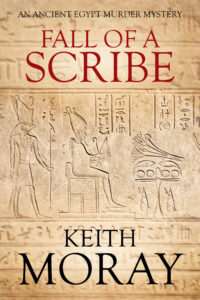
275 BC, Alexandria
Hanufer of Crocodilopolis, the captain of the Medjay police is being plagued by nightmares. Strange shadows haunting him in the night that are not banished by the gods he prays to.
He is worried it is a sign of evil to come.
And when two separate murder cases land at his door, he fears he is right.
Two prostitutes have been brutally slain in separate incidents, pointing towards a serial killer.
And a Necropolis guard has been stabbed through the eye by one of his colleagues – the murderer rambling about an evil spirit.
Things are complicated further when Hanufer is summoned to court by the High Priest to investigate rumours of a witch manipulating the Pharoah and his queen.
As his shadowy nightmares intensify, Hanufer struggles to unravel all the threads.
Are the crimes all related? Is some evil force infecting the city? Or are these foul deeds the work of man….?
We are thrilled to be celebrating five years in business this month and we are incredibly grateful to all the writers, agents and literary estate holders who have helped us bring to market such a vibrant and diverse list of books.
Since launching Sapere Books in March 2018, our list has grown to include over six-hundred books by over one hundred authors. We have sold over 3 million books to date with 500 million pages read through Amazon’s Kindle Unlimited program.
In 2019, we employed our first full-time staff member, Natalie Linh Bolderston, who now holds the title of Assistant Editor, and in 2020, Matilda Richards and Helen Jennings both also joined our editorial team. They have all been essential to our ongoing success and we are over the moon that they are continuing the journey with us as we celebrate our first big milestone.
In 2020, we launched our non-fiction list, which includes classic works by authors such as E R Chamberlin, Sir Peter Gretton and John Bowle. And we are now pleased to announce that we are also hiring another staff member to help look after our burgeoning military history and military fiction list.
Since launching, we have focussed primarily on fiction, particularly historical fiction and crime fiction, and in 2021 we created our first historical writing contest, asking for entrants to submit a series outline loosely based on briefs we set. The response was so strong that as well as signing up five prize-winners we also signed ten more authors from the shortlisted entries.
We have always been keen to foster a community among our authors. In 2020, to combat some of the isolation due to the pandemic, we started running weekly Zooms for our authors to join and chat about their writing. These have become a valuable part of our ethos and we want to continue to make our authors feel welcomed, valued and part of the Sapere Books family.
We are also proud to announce that we have been certified Carbon Neutral since 2021 and we have created our own Sapere Books forest, planting a tree for every author that we work with.
We look forward to continuing to build strong relationships within the writing community and to publishing more brilliant genre fiction to capture the imagination of readers. Thank you again to everyone who has supported us and we hope you continue to love our books!
Amy, Richard and Caoimhe
Testimonials from four of the authors who launched with us in 2018:
David Field, author of the Medieval Saga series, the Tudor Saga series and many more
By one of life’s happy coincidences, I came across Amy Durant just when the publisher that had commissioned my first historical novel series decided to close down. Five years later I’ve published over twenty historical novels with Sapere, with ten more waiting to go.
When you become a member of the Sapere family, you’re all set for a rewarding writing career. If the quality’s right, you know that your latest ‘baby’ will be assured of a good home. They provide great editing, superb covers, expert marketing, regular royalty payments and guaranteed replies to your emails. Sapere authors have indeed been smiled upon by the patron saint of aspiring writers.
Keith Moray, author of the Inspector Torquil McKinnon series
Being published by Sapere Books has been a revelation for me as a writer. From the very first moment that Isabel Atherton, my agent at Creative Authors, arranged a chat with Amy Durant it has been a fabulous experience. Over the past five years, I have seen my backlist of fiction published along with five new novels, and I have three more under contract. Every aspect of book production from editing, cover design, publicity and marketing has been handled with flair and efficiency. On top of that, communication could not be easier or quicker, and Sapere Books have created a friendly atmosphere among all of the authors that makes me feel pleased to be part of the Sapere Books family. I could not be happier than I have been with Sapere Books, who are in my opinion without parallel in the publishing industry.
Linda Stratmann, author of The Early Casebook of Sherlock Holmes and the Mina Scarletti Mysteries
Becoming a Sapere Books author is like joining a warm and welcoming family, dedicated to providing the best for authors and readers. An experienced and hardworking team offers a soundly professional service, always on hand for support and advice. The last five years has seen Sapere grow and flourish, but never losing that personal touch.
Elizabeth Bailey, author of the Lady Fan Mystery series
Working with Sapere has been the most enjoyable and rewarding publishing experience in all my thirty-odd years as an author. That my career is flourishing is testament to the care and attention given to every book. Authors are encouraged to interact and support each other, which makes me feel part of a family, parented by the nurturing and talented Sapere team. Long may they reign! Oh, and we all love our covers!
Congratulations to Keith Moray, whose gripping Scottish mystery, Deep and Deadly, is out now!
Deep and Deadly is the seventh crime thriller in the detective series featuring Inspector Torquil McKinnon: an action-packed police procedural full of suspense.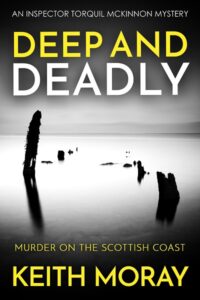
West Uist, Scotland
It’s an usually busy day on the remote island of West Uist. The only transport on and off the island is the local ferry, and there is uproar when it is blocked by eco-rights activists, protesting against the shooting of seals by local fishermen.
While dealing with that disturbance, the police are amused to find a celebrity has disembarked from the ferry and is causing a stir among the locals.
But just as the demonstration is peaceably dispersed and actor and singer Declan O’Neil is escorted away from the crowds, Detective Inspector Torquil McKinnon is called to investigate a dead body.
Fisherman Arran MacCondrum, owner of the farm that is being protested against, has been found dead in one of his fish pens, seemingly by suicide.
But with a spate of threatening poison-pen letters making their rounds on the island, it soon becomes clear that Arran’s death was not by his own hands.
Was Arran attacked by a protestor? Or was there an ulterior motive?
Torquil must unravel the mystery before anyone else on the island comes to harm…
Congratulations to Keith Moray, whose gripping historical thriller, Death of a Poet, is published today!
Death of a Poet is the first book in the Ancient Egypt Mystery series.
Hanufer of Crocodilopolis, newly appointed Overseer of the Police in Alexandria, is keen to prove himself worthy to both the citizens of the city and to the Pharaoh, Ptolemy Philadelphus.
When an altar is desecrated with a poem intended to insult the Pharaoh and his wife, Queen Arsinoe, Hanufer and his trusted sergeant Sabu are tasked with discovering who committed the outrage.
As the poet himself, Sotades the Obscene, was recently executed, Hanufer sets about finding out who else is familiar with his poetry.
Before long another poet is found murdered – a poem by Sotades left near the corpse as a macabre calling card.
With a growing number of murders to be investigated, Hanufer must make his mark and solve the mysteries.
But just where — and how high up — will the clues lead him?
Did Sotades really drown? Is there a serial killer on the loose in Alexandria?
And can Hanufer appease both the Pharoah and the gods?
Keith Moray is the author of the SANDAL CASTLE MEDIEVAL THRILLERS, historical murder mysteries set in Yorkshire. The first two books in the series, THE PARDONER’S CRIME and THE FOOL’S FOLLY, are available to pre-order.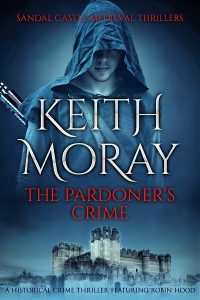
I live within arrowshot of the ruins of Sandal Castle. As a family doctor in Yorkshire, for thirty years I saw it most days while driving around the area on my morning visits. Nowadays, in semi-retirement I go running around the old battlefield where thousands of knights and soldiers once fought and died during the Wars of the Roses.
I plot and daydream when I run. Happily, a short story entitled The Villain’s Tale about a miscreant in a rat-infested dungeon in Sandal Castle won a Fish Award. It spurred me on to start plotting the Sandal Castle Medieval Thrillers.
Sandal Castle
The fine old motte and bailey was built in the 12th century by the De Warenne family during the reign of Henry I. From the 14th century it passed into royal ownership and is best known for its involvement in the Battle of Wakefield in 1460, when Richard, Duke of York was mortally wounded. His son, King Edward IV established it as one of the two bases for the Council of the North in 1472. Effectively, this was the government for the North of England. After he died, his younger brother, King Richard III began rebuilding the castle in 1483. The work stopped when he lost his life at Bosworth Field in 1485.
Thanks to television and movies, most people associate the outlaw Robin Hood with Sherwood Forest and Nottingham. However, the medieval ballads say that his stomping ground was actually Barnsdale Forest, which once covered a vast swathe of Yorkshire. The ballads also mention King Edward and various Yorkshire characters, such as George-a-Green the Pinder of Wakefield, and many actual locations in Wakefield are referred to.
The Court Rolls of the Manor of Wakefield
In medieval times, The Manor of Wakefield was the largest in Yorkshire and one of the largest in England, covering some 150 square miles. The Court Rolls of the Manor of Wakefield are a national treasure, consisting of a continuous recording of court proceedings from the late thirteenth century until the 1920s.
The outlaw and bowman Robert Hode, a sure candidate for being the historical Robin Hood, is mentioned in the Court Rolls of 1316.
The Sandal Castle Medieval Thrillers
 If you look at the picture of Sandal Castle today you will see exactly where I had the germ of the idea for The Pardoner’s Crime, the first novel in this series. It is a view of the castle from under what I fancifully call Robin Hood’s tree. I blended historical facts, medieval ballads and a good deal of imagination to come up with a historical whodunit.
If you look at the picture of Sandal Castle today you will see exactly where I had the germ of the idea for The Pardoner’s Crime, the first novel in this series. It is a view of the castle from under what I fancifully call Robin Hood’s tree. I blended historical facts, medieval ballads and a good deal of imagination to come up with a historical whodunit.
There are three completed novels and a fourth in the pipeline. They are not all about the same characters; indeed they are set at different times, because Sandal Castle with its fascinating history is the historical backdrop to them. They are all inspired by Chaucer’s The Canterbury Tales and some of the characters that he described so beautifully. The Pardoner’s Crime fuses The Canterbury Tales with the Robin Hood legends. The reader is challenged to uncover the true villain in each novel.
Click here to pre-order THE PARDONER’S CRIME.
Click here to pre-order THE FOOL’S FOLLY.
Sandal Castle image credit: Keith Moray
This Christmas, we’ve put together an anthology of festive crime fiction that is sure to give you the chills! Here’s a taste of what to expect from MIDWINTER MYSTERIES…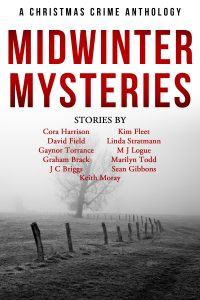
In Graham Brack’s AWAY IN A MANGER, a decidedly non-festive Lieutenant Josef Slonský investigates a string of thefts amid Prague’s bustling Christmas market.
At a Christmas Eve gathering, Charles Dickens weaves a gory, atmospheric ghost story that becomes a little too real in J C Briggs’ FOOTPRINTS IN THE SNOW.
Keith Moray’s LOST AND FOUND follows the residents of West Uist as they merrily prepare for their New Year’s Eve traditions – until one of them is found dead…
While trying to provide for his family, young Alfie finds himself investigating the disappearance of gold bars from a bullion store – which have vanished along with his beloved dog, Mutsy – in Cora Harrison’s THE SPIRIT OF CHRISTMAS.
In Seán Gibbons’ THE STOLEN SANTA SACK, unlucky driver Ben Miller is stuck with a dead Santa Claus and a sackful of cash in the back of his cab…
While hurrying to develop her clients’ portraits in time for Christmas, photographer Julia McAllister is landed with a drunken newlywed and a photograph of a ghost in Marilyn Todd’s WILL POWER.
Gaynor Torrance’s CHRISTMAS SPIRITS follows headstrong Detective Inspector Jemima Huxley as she finds herself caught up in an armed robbery while doing her Christmas shopping.
In David Field’s THE ESSEX NATIVITY, Detective Sergeant Jack Enright discovers a destitute couple expecting their first child in the shelter of a barn.
When one of her clients is stalked by a mysterious figure, Private Investigator Eden Grey attempts to uncover the unwelcome follower in Kim Fleet’s SECRET SANTA.
Major Thankful and Thomazine Russell investigate the theft of a scandalous manuscript written by the king in M J Logue’s STIR UP SUNDAY.
In Linda Stratmann’s THE CHRISTMAS GHOST, wilful sleuth Mina Scarletti attempts to bring peace to a woman haunted by the spirit of her dead son.
Click here to order MIDWINTER MYSTERIES!
Hi Keith. Welcome to the Sapere Books blog!
Can you tell us a little bit about what first inspired you to write the Torquil McKinnon Investigations?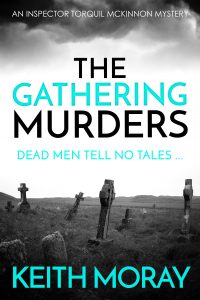
Well, I have been a crime fiction reader most of my life and always wanted to be a crime writer. I began writing children’s stories for The People’s Friend when I was a medical student at the University of Dundee. Then when I qualified, I wrote for the Kingston-upon-Hull’s dial-a-bedtime story service, until I had to give it up and focus on my medical practice. One of my forebears was a piper, and I thought that if I ever did write a crime novel it would have a piper in it. The germ of an idea was there.
A few years later I started having bagpipe lessons from a good friend and golf partner, who happened to be a retired pipe major. So, actually playing the pipes seemed to germinate the idea. Then we went on a family holiday to Tobermory in Mull and the whole thing seemed to unfold before me. A remote Outer Hebridean island with a primitive golf course and the smallest police force in the country, the Hebridean Constabulary. The ingredients were there, it just took a visit to a Highland Gathering on the mainland and I started to plot The Gathering Murders. The characters grew on me and the series just developed.
What was your reason for creating the fictional island of West Uist instead of choosing a real Scottish location?
I suppose I just fell into it. I had written several westerns long before I ever went to the USA, so I just started writing, amalgamating my own memories into my own wee island in much the same way that I had created towns and counties in the Southwest of America. I wanted West Uist to be Scotland in miniature. This is why the terrain varies, there is a great variety of surnames (far greater than in the Outer Hebrides) and I have introduced a different theme with each novel.
What are your typical writing habits? Do you work on a set schedule each day? Do you plan thoroughly before you begin writing?
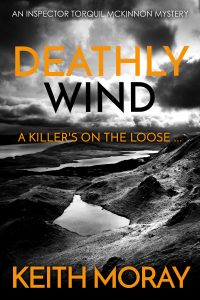 I am an opportunistic writer, so I write when I have done all of my essential chores for the day, such as looking after my small practice. I am also a medical journalist and have a written a weekly column in the local newspaper for 38 years, so I can identify with Calum Steele, the editor of the West Uist Chronicle. Because I used to write short children’s stories and now write a newspaper column, I tend to write in short segments. It has become part of my writing psyche. This suits my opportunistic method of working.
I am an opportunistic writer, so I write when I have done all of my essential chores for the day, such as looking after my small practice. I am also a medical journalist and have a written a weekly column in the local newspaper for 38 years, so I can identify with Calum Steele, the editor of the West Uist Chronicle. Because I used to write short children’s stories and now write a newspaper column, I tend to write in short segments. It has become part of my writing psyche. This suits my opportunistic method of working.
I carry a notebook everywhere and am forever jotting snippets down, to be incorporated later. I plot late at night in longhand. When I am actually writing then it will be on the computer, and that can be literally any part of the day.
I do plan it out and have never felt brave enough to just type and see where the story goes. I have a method of writing a novel that seems to work for me. A crime novel has so many elements to it: main plot, subplots, clues and red herrings. I work out each chapter and have a fair idea of what has to happen in each one.
What part of the writing process do you find most difficult?
Plotting is never easy. I go around asking myself ‘what if?’ That’s why I need my notebook handy. I would say it is 80 per cent of the work in writing the novel.
When I am working on the plot, I often play the pipes like Torquil (except he is a virtuoso and I am so abysmal that I am forbidden from playing if there is anyone else in the house). And I also putt golf balls across the landing into my study or chip balls onto the settee. Strangely enough, it facilitates ideas.
In terms of the visceral structure of the novel when I actually write, the middle part is the hardest for me. The first part is scene setting, putting people in the right places and ensuring that the crime happens early on. The middle part is about planting the clues, the red herrings and keeping the subplots going without letting them take over. The end part I already know what should happen, so the middle is about ensuring that you have put everything in place so that you can build it up for the final denouement.
Do you always know ‘who done it’ before you start drafting each novel?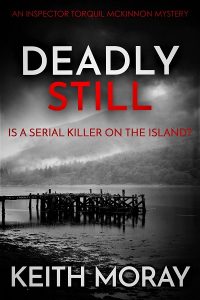
Yes, in virtually all of my books I know who, where, when and how. But, I have to admit that I have on one occasion changed my mind while well into the story. It seemed to work, but I’m saying no more!
The sixth book in the series is due out soon – will that be the end for Torquil, or do you have ideas for more mysteries?
Gosh, I am honestly not sure. I would like to think there will be more, but I am working on other projects at the moment, which I am excited about. Torquil may not have finished with me yet.
And finally – tell us something surprising about yourself!
One of my hobbies is conjuring and I am a paid up member of the International Brotherhood of Magicians.
Click here for more information on Keith Moray’s Torquil McKinnon Investigations series.
THE DEADLY STILL, book five in the series, is available to preorder now.
I began my writing career many moons ago when I was studying medicine at the University of Dundee in Scotland. At that time the city was famous for the ‘three J’s’ of Jute, Jam and Journalism. Journalism referred to the publishing firm of D C Thomson, which produced the famous Beano comic and countless other publications.
I submitted a few children’s stories to the People’s Friend, a well known family magazine that is still going strong today. To my surprise and delight they were accepted and I was soon regularly writing stories for the Children’s Corner on the inside back page. 
Then once I had graduated I moved to Hull. While I was working in cardiology I learned that the Kingston-upon-Hull telephone exchange had a ‘dial-a-bedtime’ story service. For the cost of a phone call parents could have a short three-minute bedtime story told to their youngsters over the phone. My stories were soon being recorded and heard by youngsters all over the city.
Inevitably, I longed to have my name on the spine of an actual book. It was then that I came across that old adage, ‘write about what you know.’ It is one of the nuggets of writing wisdom, except it is often misinterpreted.
In my case as a medical doctor I assumed that it mean that I should write a medical thriller or maybe a medical romance. My problem was that I worked in medicine and didn’t want to spend my thinking and writing time in medicine as well. So I had several false starts on various non-medical novels, and like most writers I have a drawer full of opening chapters for several books that never saw the light.
Then it dawned on me. It didn’t mean that I had to write exclusively about a medical world, but that I should use my medical knowledge to really make a character stand out and be believable. Or I should be able to drip in details about drugs, operations, or snippets of medical history, to give the work authenticity. And that is just what I did in my first western novel Raw Deal at Pasco Springs. I did the same with several other westerns before turning to crime!
I began by creating West Uist, an island in the Outer Hebrides of Scotland and peopled it with believable characters, including the local doctor, who doubles as a police surgeon. On the island my detective, Inspector Torquil McKinnon can solve crimes using his brains rather than depending upon forensic science and DNA. Yet in The Gathering Murders, the first novel in the series there is still plenty of medicine peppering the plot.
Crossing one genre gives you the confidence to do it again. The bridge that I use is medicine. I am able to create believable medical situations. For example, I write collaborative western novels with some other writers in the USA. We have created a town called Wolf Creek and each collaborator writes one or two chapters per novel from the viewpoint of his or her character.
My character is Dr Logan Munro the town doctor, who extracts bullets, sets broken bones and delivers babies. Similarly, I use my knowledge of the history of medicine in my historical novels, The Pardoner’s Crime and The Fool’s Folly, which are set in the thirteenth and fourteenth centuries.
Essentially, my message is that you don’t have to set your story in your relevant world. What you can do is drop in a character that shows your expertise. That is my interpretation of the axiom ‘write about what you know.’


